Key takeaways:
- Community feedback is vital for music labels, fostering emotional connections and a sense of belonging among fans.
- Engaging with feedback during planning improves project outcomes and aligns the label’s direction with audience preferences.
- Effective feedback methods include listening parties, surveys, and social media polls, enhancing real-time interaction and insights.
- Evaluating changes requires monitoring long-term community reactions, balancing quantitative metrics with qualitative emotional responses.
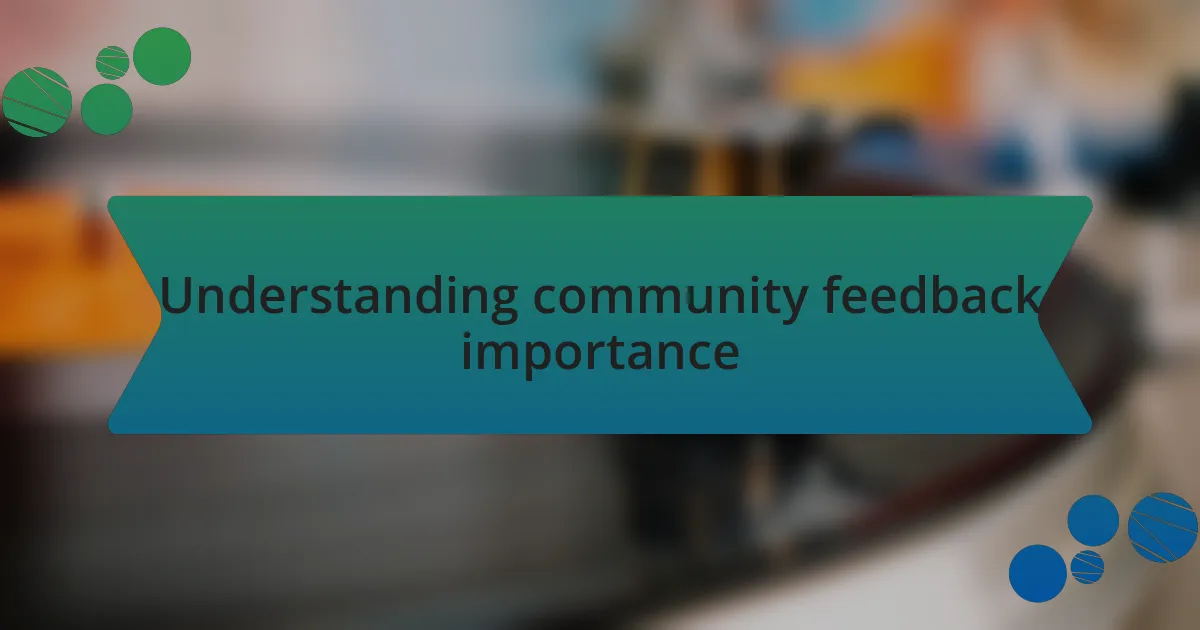
Understanding community feedback importance
When I think about community feedback, I see it as the lifeblood of any music label. It’s not just about numbers or statistics; it’s about understanding what resonates with listeners. Have you ever felt that a song truly speaks to you? It’s that emotional connection that feedback helps us nurture.
Reflecting on my experience, I recall a time when our label released an EP that we thought was innovative. Yet, the community’s response revealed that our audience was craving a return to the classic sounds of earlier days. This served as a powerful reminder that sometimes, what we love as creators doesn’t always align with the pulse of our listeners.
Moreover, integrating feedback fosters a sense of belonging among fans. It creates an atmosphere where they feel valued and heard. How essential is that in a world full of noise? By leveraging their insights, we not only improve our offerings but also build a loyal community that feels invested in our journey.

Role of feedback in planning
Feedback plays a vital role in the planning stages of any project, especially in the dynamic world of electronic music. I remember when we were deliberating over the artwork for our latest release. A simple question from a passionate fan prompted us to rethink our entire approach, leading to a design that resonated far more deeply with our audience. Could I have envisioned that change without their input? Likely not.
It’s fascinating how feedback shapes not only decisions but also our vision as a label. I once faced a dilemma between pursuing experimental sounds and sticking to familiar tunes that our community loved. After engaging directly with our fans through social media polls and listening sessions, I realized that aligning our direction with their preferences resulted in more profound connections and, ultimately, better reception. Isn’t it amazing how a simple dialogue can transform the course of a project?
Listening to community feedback isn’t just beneficial; it’s essential for creating a successful label. When we actively solicit and integrate this feedback, we foster an environment where creativity thrives based on shared experiences. In my view, this collaborative spirit not only enhances our planning process but also enriches the overall atmosphere of our music label, turning our audience from passive listeners into active participants.
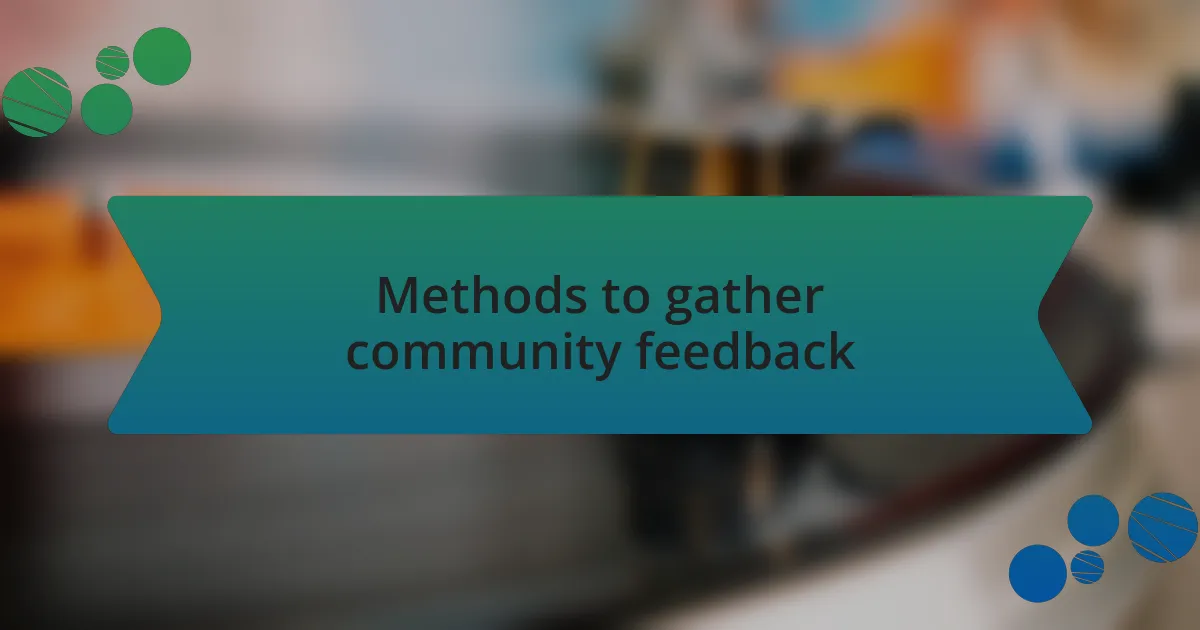
Methods to gather community feedback
When it comes to gathering community feedback, there are several effective methods that I’ve found to be particularly impactful. One of my favorites is hosting listening parties where fans can experience upcoming releases while sharing their thoughts in real time. I remember the excitement in the room during one such event, where the energy of the audience directly influenced minor tweaks to the tracks based on their reactions. Isn’t it powerful how live interaction can lead to immediate and meaningful changes?
Surveys and questionnaires can also serve as a treasure trove of insights. I’ve often used tools like Google Forms to create structured feedback sessions after shows or releases. Whether it’s a simple question about how they felt about a specific track or more open-ended queries about their overall experience, the data we collect can truly guide our future projects. I always find it fascinating how even a single insightful comment can spark an entirely new direction for our label.
Social media is another essential platform to tap into community sentiment. I’ve discovered the value of creating polls on platforms like Instagram or Twitter, which not only engage our audience but also provide instant feedback on decisions ranging from track selections to event themes. A memorable instance was when a poll about album art colors turned into a lively discussion, letting fans feel actively involved. Isn’t it amazing how a few clicks can open such a rich dialogue?
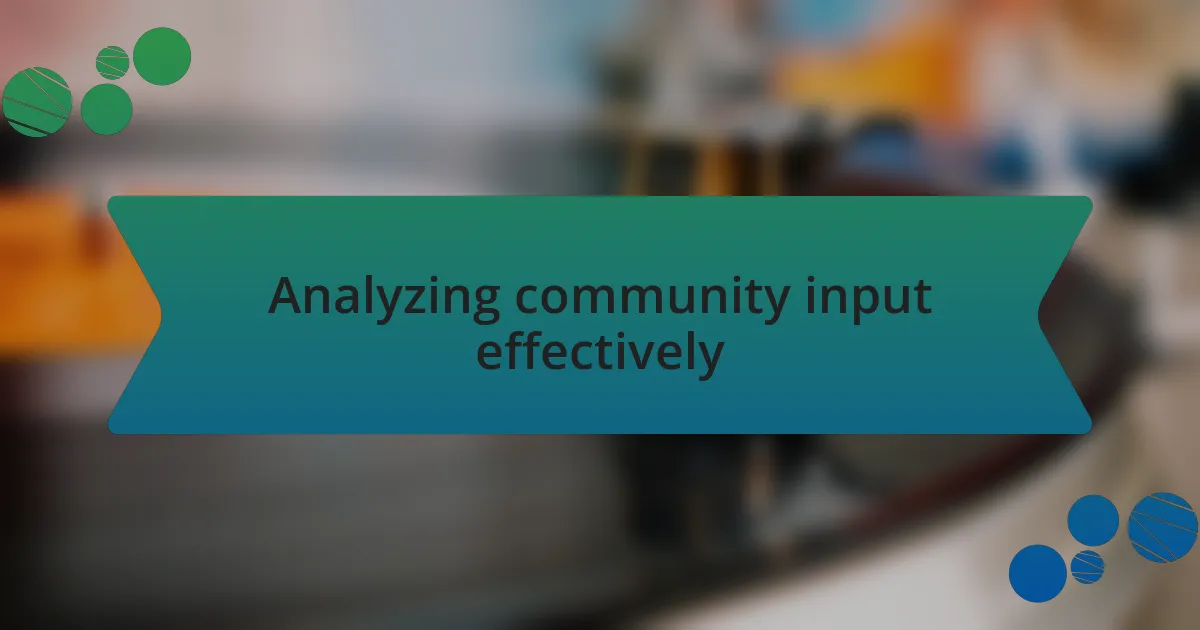
Analyzing community input effectively
Analyzing community input effectively is about diving deep into the feedback we receive. I recall a time when we received mixed reviews on a particular track. Rather than brushing the feedback aside, I organized a focused listening session, inviting a few select fans to discuss their thoughts. This intimate setting allowed us to understand the emotional connections people had to the music, ultimately leading to adjustments that made the final release resonate better with our audience. Can you imagine how much more relatable those tracks became after such conversations?
It’s crucial to categorize feedback into actionable insights. I often create themes from the comments we gather, distinguishing between constructive criticism and personal preferences. For example, a recurring theme might highlight the desire for more bass in our tracks. When multiple fans mention this, it’s not just a passing preference; it’s a trend that warrants our attention. By viewing feedback through this lens, I can prioritize enhancements that will significantly impact our audience’s experience. Doesn’t it feel rewarding to see targeted changes received with enthusiasm?
Lastly, don’t underestimate the power of context in analyzing feedback. I remember a time when we released a piece right before a major festival. The responses varied dramatically, influenced by listeners’ moods and expectations. By considering the timing and surrounding events, I could gauge whether the critiques were reflective of our music or more about the atmosphere. It’s fascinating how situational factors play into appreciation, isn’t it? This understanding has helped me frame our creative decisions more strategically.
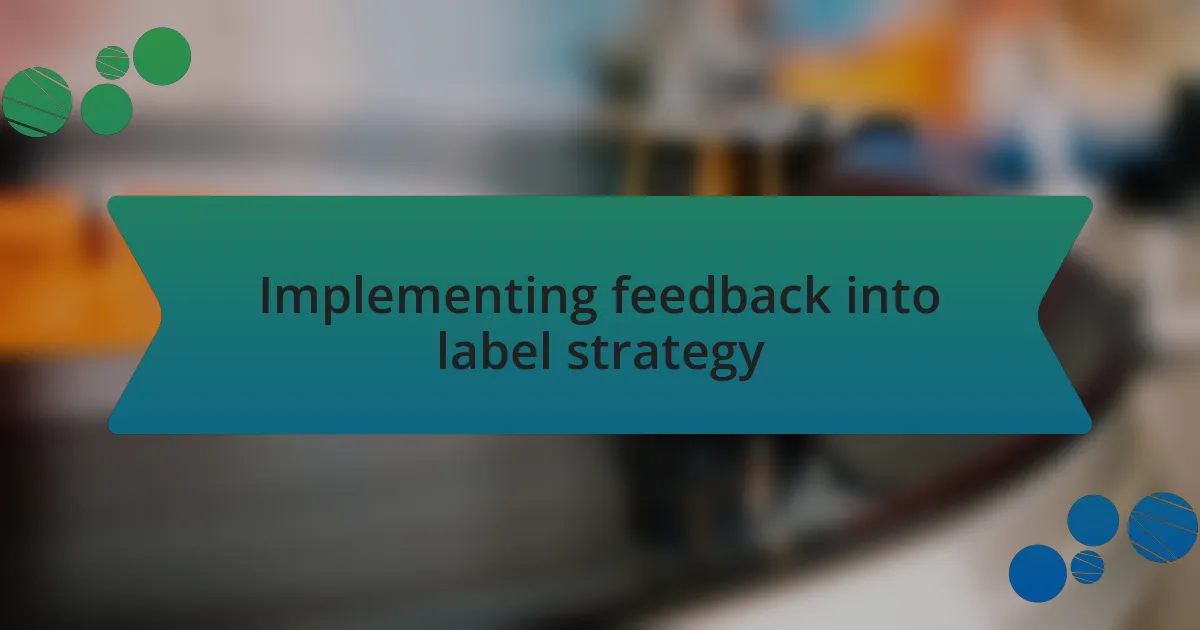
Implementing feedback into label strategy
Implementing community feedback into our label strategy is an ongoing journey that requires a thoughtful approach. For instance, after a promotional campaign, we received feedback suggesting that our social media presence could be more interactive. I took this to heart and initiated regular Q&A sessions with our artists, allowing fans to connect directly and share their music preferences. It’s amazing to see the enthusiasm when fans feel valued and involved—don’t you think that a personal touch can really strengthen the bond between an artist and their audience?
In another instance, we faced a decision on whether to release a remix album. Community feedback highlighted both excitement and skepticism about the concept. By organizing a poll, I engaged our listeners in the decision-making process. The response was illuminating; many fans wanted to see remixes by specific artists. This insight not only shaped our release strategy but also fostered a sense of ownership among our followers. Isn’t it incredible how involving the community can yield direction and unity in our label’s mission?
Every piece of feedback leads to a potential shift in direction, but it’s up to us to interpret and implement it thoughtfully. I remember a time when we hesitated to explore a new genre based on initial pushback. However, reader interest in an experimental sound began to surface repeatedly. Listening to our fans and taking the leap not only expanded our catalog but also attracted a whole new audience. Have you ever experienced the thrill of venturing into the unknown? The result reaffirmed my belief in the community’s intuition as a guiding light in our strategy.
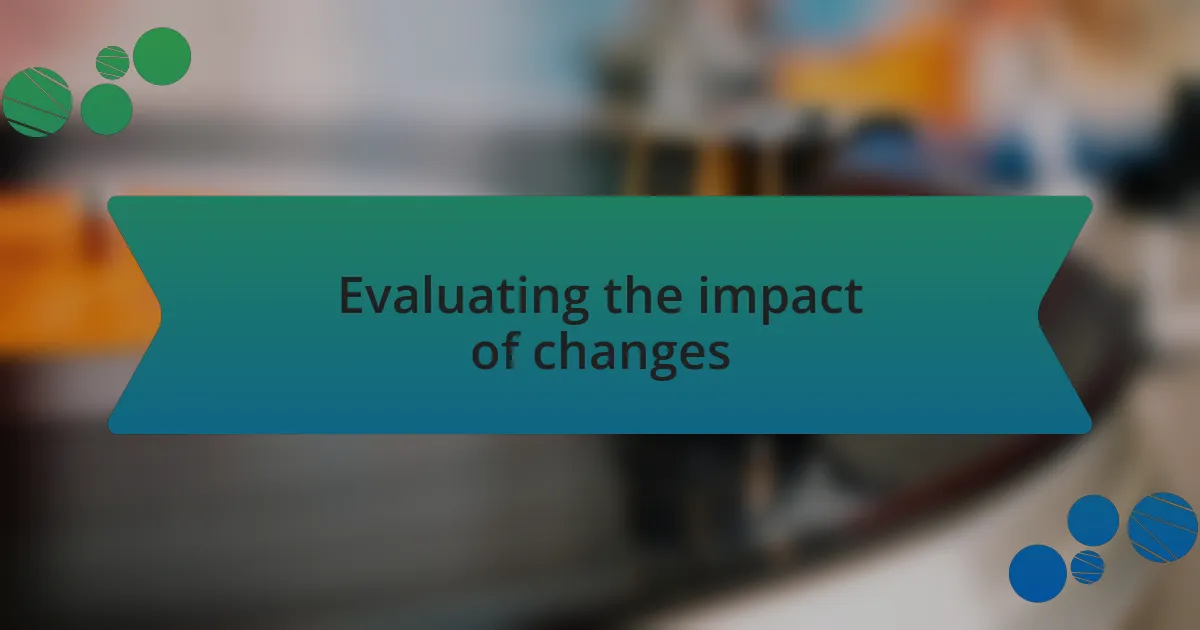
Evaluating the impact of changes
Evaluating the impact of changes involves closely monitoring community reactions over time. After implementing feedback from a recent event, I created surveys to measure engagement levels and satisfaction. The insights I gathered showed not just immediate responses but also long-term shifts in how our audience connected with our label. Isn’t it interesting how those initial reactions can evolve into more profound emotional investments?
I recall hosting a live-streamed performance after our listeners expressed a desire for more interactive content. The post-event feedback revealed that not only did the audience appreciate the experience, but many felt a stronger connection to our artists. Did you ever realize that creating these moments can translate into lasting loyalty? That connection was a powerful reminder that evaluating our changes shouldn’t just focus on numbers; it should also capture the emotional resonance we create.
Furthermore, it’s crucial to keep an eye on the trends following our adaptations. I often review metrics alongside qualitative feedback, such as comments and social media conversations. This dual approach helps me understand the nuances of community sentiment better. Have you noticed how sometimes data tells one story, while emotions tell another? Balancing both perspectives is key to ensuring our adjustments resonate and thrive within the electronic music community.
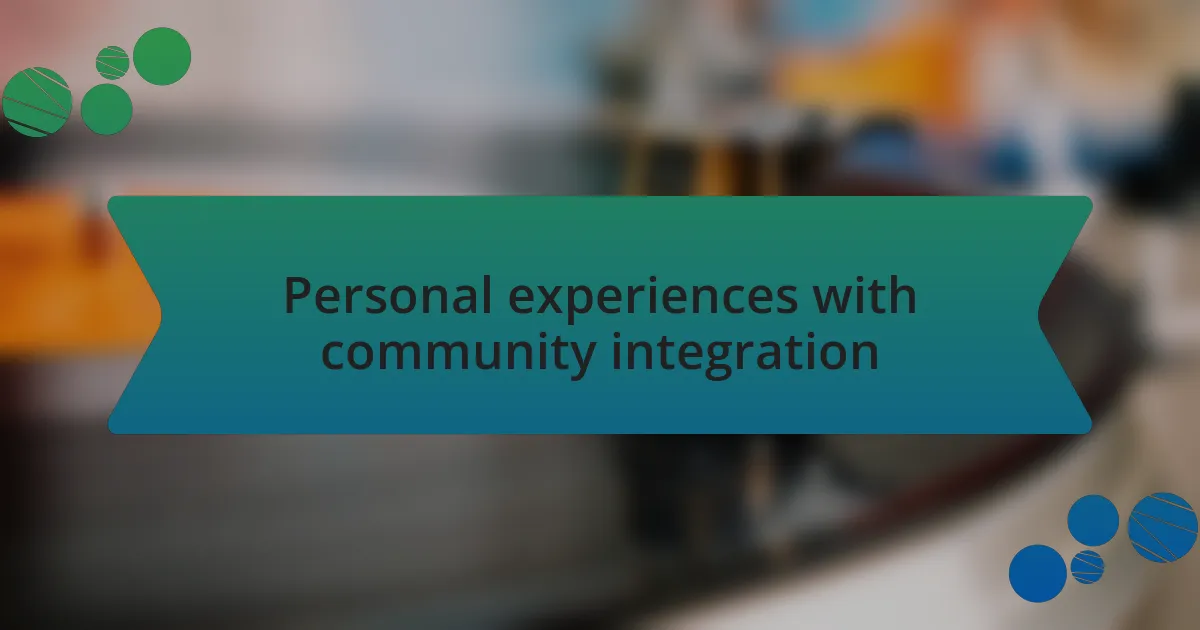
Personal experiences with community integration
When I first took the plunge to incorporate community feedback into our planning, I was initially overwhelmed. During a brainstorming session, someone suggested we host a community remix contest. I hesitated, thinking it might be too chaotic. However, the thrill of seeing so many submit their creations transformed my perspective. It wasn’t just about the music; it was about shared creativity, and I started to see our label as part of a larger creative ecosystem.
One memorable experience was when I piloted an open discussion forum after a major release. I expected some feedback, but the depth and enthusiasm of the community blew me away. It felt like a true exchange rather than a simple Q&A. I remember one fan sharing how a particular track helped them through a tough time. That moment crystallized for me how essential our label was in their life. Isn’t it fascinating how a single interaction can illuminate your path forward?
I’ve also learned that integration is an ongoing journey, not a destination. I often revisit past feedback to see how it aligns with current trends and sentiments. A few months back, I noticed recurring themes about inclusivity in our events. Delving into those conversations sparked the idea for a collaborative workshop with emerging artists and fans. Isn’t it amazing how looking back can inspire innovative ideas for the future? Engaging with our community consistently shapes the evolution of our label in ways I never anticipated.